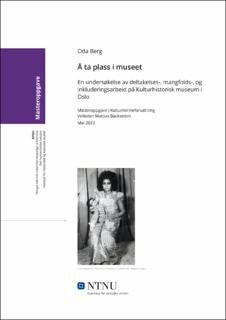| dc.description.abstract | Denne masteroppgaven, som springer ut av min praksisperiode, er en undersøkelse av deltakelses-, mangfolds- og inkluderingsarbeidet som er gjort på Kulturhistorisk museum i Oslo fra 2014 til 2021. Problemstillingen for oppgaven er: Hvordan jobber Kulturhistorisk museum i Oslo med deltakelse, inkludering og mangfold i sin nåværende utstillingsvirksomhet? Jeg har undersøkt dette ved å ta for meg tre forskjellige utstillinger som ble stilt ut i denne perioden: «Ja, vi elsker frihet» (åpnet i 2014), «Kongoblikk – Blikk på Kongo» (åpnet i 2016) og «Memory on the horizon» (åpnet i 2021). Her ser jeg på hvordan museet har samarbeidet med de eksterne gruppene som var involvert i utstillingene. Altså hvor mye de er blitt involvert i den helhetlige prosessen før, under og etter at utstillingene er åpne for publikum. For å undersøke og drøfte problemstillingen baserer jeg meg på to forskningsmetoder: intervju og dokumentstudier. Jeg har intervjuet tre informanter, som alle jobber på Kulturhistorisk museum og har vært sentrale i deltakelses-, mangfolds-, og inkluderingsarbeidet. I dokumentstudiet ser jeg på årsplanene som gjør seg gjeldene fra 2014 til 2021. Disse bruker jeg for å få nyttig innsikt i intensjonen bak avgjørelser innad i Kulturhistorisk museum som er koblet opp mot utstillingene. I tillegg til dette ser jeg på repatrieringsprosjektet «Bååstede», før jeg til slutt undersøker stillingsbeskrivelsen for museets mangfoldskurator.
I denne masteroppgaven konkluderer jeg med at Kulturhistorisk museum har brukt en rekke forskjellige tilnærminger til dette arbeidet, og at graden av deltakelse fra eksterne grupper har vært variert. De tre utstillingene bruker tre av kuratoren og museologen Nina Simons fire modeller for deltakelse: den medvirkendemodellen, samarbeidsmodellen og den medskapende modellen. Når jeg bruker Simons modeller i analysene mine ser jeg en tydelig økning i tråd med den kronologiske rekkefølgen av utstillingsprosjektene. Hvis man derimot ser på hele utstillingsprosessen, spesielt i etterkant av utstillingen, hadde «Ja, vi elsker frihet» bruke den medvirkende modellen med minst deltakelse. «Kongoblikk – Blikk på Kongo» baserte seg på samarbeidsmodellen som hadde mindre grad av deltakelse i selve prosjektet, men var etterfulgt av mye oppfølgning til prosjektet. «Memory on the horizon» brukte den medskapende modellen som var best på deltakelse i selve prosjektet, men sviktet litt i etterarbeidet. Uansett kan man si at Kulturhistorisk museum har blitt mer opptatt av deltakelse, mangfold og inkludering i nåtiden enn for kun ti år siden. | |
| dc.description.abstract | This master’s thesis, which has its origins from my internship period, is a study of the participation, diversity and inclusion work done at the Cultural History Museum in Oslo from 2014 to 2021. The problem for the thesis is: How does the Cultural History Museum in Oslo work with participation, inclusion and inclusion and diversity in their current exhibition activities? I have examined this by considering three different exhibitions that were exhibited during this period: “For the Love of Freedom” (opened in 2014), “Congo look - Look at the Congo” (opened in 2016) and “Memory on the horizon” (opened in 2021). Here I look at how the museum has collaborated with the external groups that were involved in the exhibitions. That is, how much has been done in the overall process before, during and after the exhibition was open to the public. To investigate and discuss the problem, I base myself on two research methods: interview and document studies. I have interviewed three informants, all of whom work at the Cultural History Museum and have been central in the participation, diversity, and inclusion work. In the document study, I look at the annual plans that apply from 2014 to 2021. I use these to gain useful insight into the intention behind decisions in the Cultural History Museum that are linked to the exhibitions. In addition to this, I look at the repatriation project “Bååstede” before I finally examine the job description for the museum's diversity curator.
In this master's thesis, I conclude that the Cultural History Museum has used several different approaches to this work, and that the degree of participation from external groups has varied. The three exhibitions use three of the curator and museologist Nina Simon's fire models for participation: the contributing model, the collaborative model, and the co-creative model. When I use Simon's models in my analyzes, I see a clear increase in line with the chronological order of the exhibition projects. If, on the other hand, one looks at the entire exhibition process, especially after the exhibition, “Yes, we love freedom” had to use the participating model with the least participation. “Congo Gaze – People, Encounters and Artifacts” based on the collaboration model that had less participation in the project itself but was followed by a lot of follow-ups to the project. “Memory on the horizon” used the co- creative model that was best at participating in the project itself but failed a bit in the follow- up. In any case, it can be said that the Cultural History Museum has become more concerned with participation, diversity, and inclusion in the present than just ten years ago. | |
